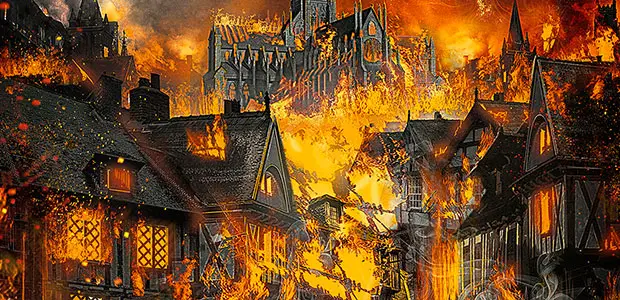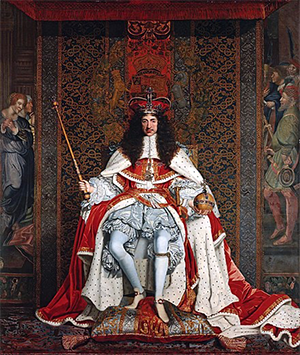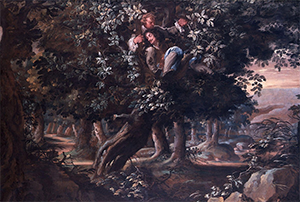King Charles II of England
Charles II was King of England for 25 years in the last 17th Century. The beneficiary of the Restoration, he followed his father on the throne, which was left vacant for a time while a Commonwealth ruled the realm. 
He was born on May 29, 1630, in St. James's Palace in London, the oldest son of King Charles I and the heir apparent to the throne. When he was 12, the English Civil Wars began. Young Charles did fight in in the First Civil War, leading the West Country Royalists for a time in 1645. When he was 19, his father was executed. He was in the Netherlands at the time, having flown into exile at the end of the Second Civil War. In 1650, Charles returned to the British Isles, accepting the kingship of Scotland and leading an invasion army into England. This Third English Civil War ended the same way the first two had–with a victory for Oliver Cromwell
and the Parliamentarians, and Charles again fled to the Continent. Cromwell's forces had won the Battle of Worcester, and Charles spent the next six Cromwell, named Lord Protector in 1653, died in 1658, and his son Richard took over the post. He had no support and resigned in early 1659. The following year, a group of nobles called Charles back to England, offering him the crown. He became King Charles II in 1660, agreeing to the terms of the Petition of Right, which his father had also agreed to 12 years before. This set of rules required the king to seek Parliament's approval before launching any other tax collection schemes. Also in the Petition of Right were prohibitions on the king's declaring martial law, requiring people to keep troops in their homes, and imprisoning people without due process of law. He was crowned on April 23, 1661. Soon afterward, he named his brother James the head of the Royal Navy. Charles also, even though he personally preferred to promote religious tolerance, paid nominal attention to the Clarendon Code, a series of laws named for his chief minister, Edward Hyde, 1st Earl of Clarendon, that affirmed the supremacy of the Church of England. One of the laws, the 1662 Act of Uniformity, required all clergy to use the Book of Common Prayer in religious services. 
Charles had an eventful reign, both domestically and internationally. He founded the Royal Society in 1660. London suffered through a great plague in 1665 and a great fire the following year. He oversaw two wars against the Netherlands. Charles believed, as his father did, in the divine right of kings. He had learned from his father's example, however, not to make too much of this belief. He knew that he depended on Parliament to raise revenues, and he encouraged good relations between himself and the Members of Parliament as far as he could. He also signed a secret treaty with France's King Louis XIV that brought in aid for the war against the Dutch; as part of this treaty, Charles agreed to convert to Catholicism.  The Catholic-Protestant divide was still strong in England during this time. His father had angered many people by marrying a Catholic princess. Charles himself did the same thing, marrying Catherine of Braganza, the Catholic daughter of Portugal's King John IV. But the royal couple had no children, and the heir to the throne was James, Charles's brother, and James was a known Catholic. Charles secretly believed in the teachings of Catholicism and, in fact, converted to the faith on his death bed. He died on Feb. 6, 1685. His brother became King James II. Charles had ensured that his niece, Mary, married a Protestant, William of Orange. The two of them would rule England themselves not long after Charles died. Charles also presided over a time of cultural reawakening and social change. The Restoration was more than just the return of the monarch. The devout Puritan Cromwell had closed the theaters. Charles reopened them, and a new type of performance known as Restoration Comedy became popular. Charles also required women to play female roles onstage; the practice had been for young boys to play the parts of women. A general happiness returned to the realm in the wake of the end of nearly 20 years of warfare. Charles was known as the "Merry Monarch." |
|
Social Studies for Kids
copyright 2002–2025
David White



 weeks trying to avoid capture. He led pursuing Parliamentarians on a merry chase for a time, taking refuge in the homes of Royalist sympathizers. In one instance, he took on the guise of a farm laborer to avoid detection. The families who kept him safe taught him to talk, walk, and act like a commoner. He narrowly avoided capture several times, at one point hiding in an oak tree (that later was known as the Royal Oak). He took on the role as the servant boy William Jackson for a time, attempting to escape with a woman named Jane Lane. He tried various other schemes to avoid detection and finally boarded a ship and sailed across the English Channel to safety, arriving in France on Oct. 16, 1651. He went to Paris to stay with his mother, who had been there since the death of her husband.
weeks trying to avoid capture. He led pursuing Parliamentarians on a merry chase for a time, taking refuge in the homes of Royalist sympathizers. In one instance, he took on the guise of a farm laborer to avoid detection. The families who kept him safe taught him to talk, walk, and act like a commoner. He narrowly avoided capture several times, at one point hiding in an oak tree (that later was known as the Royal Oak). He took on the role as the servant boy William Jackson for a time, attempting to escape with a woman named Jane Lane. He tried various other schemes to avoid detection and finally boarded a ship and sailed across the English Channel to safety, arriving in France on Oct. 16, 1651. He went to Paris to stay with his mother, who had been there since the death of her husband.
